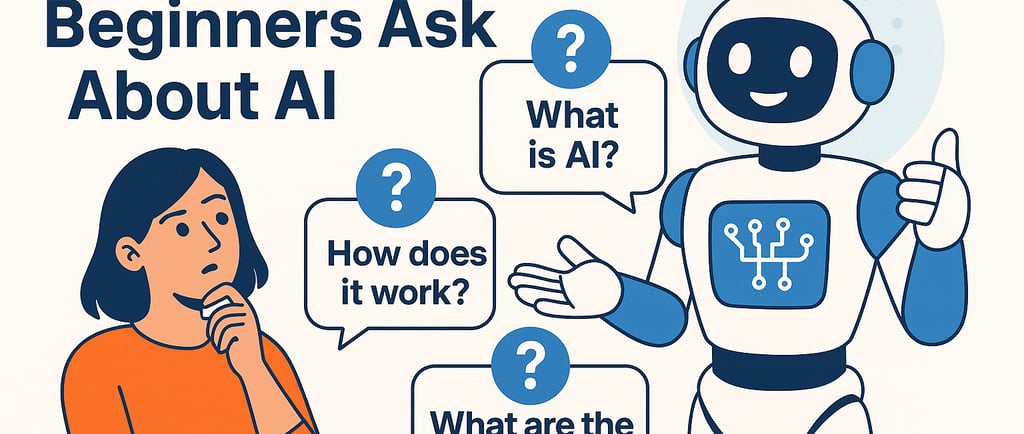Demystifying AI for Newcomers
Discover clear answers to the top 3 questions beginners ask about AI, including what it is, how it works, and its risks. Learn fast with this friendly guide!
Shannon McDowell
7/27/20253 min read


Demystifying AI for Newcomers
Artificial intelligence often feels like science fiction until you realize it’s recommending your next podcast or helping doctors diagnose diseases. If you’re new to AI, you probably have three burning questions: What is AI? How does it actually learn? Should we be worried about it? Let’s explore these topics in a way that’s friendly, informative, and occasionally witty.
What exactly is AI?
AI refers to technologies that simulate aspects of human intelligence—such as understanding language, seeing patterns in images, or making decisionsleexi.ai. You’ve likely encountered it in voice assistants, streaming recommendations, spam filters, navigation apps, or even when your phone suggests words as you type.
Narrow AI, the kind you interact with daily, is designed for a specific task and can’t easily switch contextsleexi.ai. For instance, a recommendation engine won’t suddenly start driving a car.
General AI is a hypothetical system that could tackle any intellectual task a person can handleleexi.ai. Researchers are still chasing this dream.
Super‑intelligent AI would surpass human capabilities across the boardleexi.ai. It’s currently fodder for sci‑fi novels.
Beyond these categories, AI’s reach is broad. In medicine it analyzes images, aids diagnosis, and even designs drugsweka.io. In finance it detects fraud and powers credit scoringweka.io. In transportation it enables self‑driving vehicles to recognize objects and make split‑second decisionsweka.io. It also drives natural language processing in virtual assistants and translation toolsweka.io. In short, AI is a toolbox, not a single gadget.
How does AI learn and improve?
Think of AI as an eager student. It consumes piles of data, looks for patterns, and gradually refines its answers. The basic workflow involves:
Collecting and cleaning data – AI systems gather text, images, audio, or sensor data, then preprocess it to remove errors and standardize formatsleexi.ai. High‑quality data is essential because biases in the data can lead to biased decisions.
Discovering patterns – Algorithms analyze the data to find relationships and structuresweka.io. In deep learning, neural networks process information through layers that mimic the way neurons fire in a brainleexi.ai.
Making decisions – After training, the AI generates outputs: classifying an image, suggesting a product, answering a question, or driving a carweka.io.
AI learns through different techniques:
Supervised learning uses labeled examples; the system is told “this is a cat” or “this is fraud” and adjusts its model accordinglyweka.io.
Unsupervised learning searches for patterns in unlabeled data—useful for clustering customers or discovering topics in articlesweka.io.
Reinforcement learning rewards or penalizes actions, enabling AI to master tasks like game playing or robotic controlweka.io.
As AI feeds on more data, it iteratively improves. This is why chatbots become more helpful over time and recommendation engines seem to “understand” your taste better. However, this dependence on data is a limitation: without diverse, high‑quality datasets, AI can misinterpret or over‑generalizeleexi.ai.
Should we fear AI or embrace it?
AI is a double‑edged tool. It boosts productivity and tackles problems that once seemed intractable, but it can also raise ethical and social concerns.
The upside
AI automates routine tasks, freeing people for more creative and strategic work. In healthcare it helps doctors detect diseases earlier and tailor treatmentsweka.io. In environmental science it monitors ecosystems and models climate patternsweka.io. Businesses use AI to personalize customer experiences and predict market trendsleexi.ai.
The downside
Because AI acts on data, it can inherit biases from its training sets, leading to unfair outcomes. AI could be misused for surveillance, misinformation, or autonomous weaponryleexi.ai. Training large models consumes significant energy and resourcesweka.io. And yes, automation threatens certain jobs, especially those involving repetitive tasksleexi.ai.
A realistic outlook
AI isn’t sentient, and it won’t develop human emotions or moral judgment anytime soonleexi.ai. It excels in narrow domains but fails at context and creativity. Rather than replacing humans, AI often augments them: chatbots handle simple queries while agents tackle complex cases, and robots perform dangerous jobs while humans oversee and innovateleexi.ai. The growth of AI is also creating new roles in data science, ethics, and governance.
The key to a positive AI future is responsible development and regulation. Designers must enforce ethical standards, avoid discrimination, and protect privacyleexi.ai. Policymakers should set guidelines for transparency and accountability. As users, staying curious and informed empowers us to harness AI’s benefits while advocating for fair and sustainable practices.
In summary: AI is already a part of our lives, from streaming recommendations to medical diagnostics. Understanding what it is, how it works, and how to approach its risks helps demystify the technology. By partnering with AI thoughtfully, we can tackle big challenges and shape a future where humans and intelligent machines thrive together.
Transformative AI Solutions
© 2025. Transformative AI Solutions.
All rights reserved.
Contact: admin@transformativeaisolutions.com
Legal